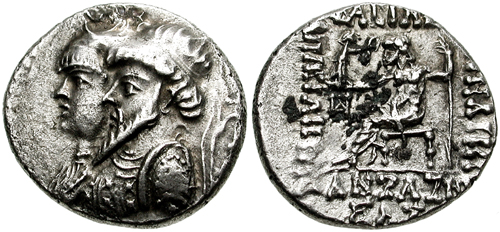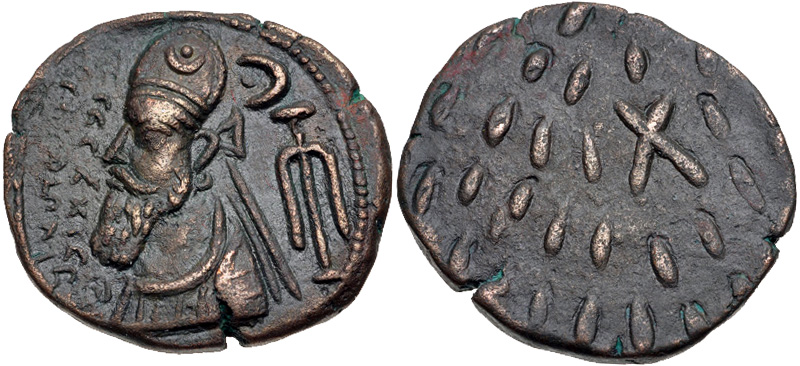Elymais on:
[Wikipedia]
[Google]
[Amazon]
Elymais or Elamais (Ἐλυμαΐς, Hellenic form of the more ancient name,

 The
The
Elymais coinage
*https://web.archive.org/web/20051223234605/http://www.grifterrec.com/coins/elymais/elymais.html *http://www.seleukids.org/Elymais.html
{{Coord, 32, 19, N, 48, 26, E, type:country, display=title 140s BC establishments States and territories established in the 2nd century BC Parthian Empire Ancient peoples Numismatics Former countries in the Middle East
Elam
Elam (; Linear Elamite: ''hatamti''; Cuneiform Elamite: ; Sumerian: ; Akkadian: ; he, עֵילָם ''ʿēlām''; peo, 𐎢𐎺𐎩 ''hūja'') was an ancient civilization centered in the far west and southwest of modern-day Iran, stretc ...
) was an autonomous state of the 2nd century BC to the early 3rd century AD, frequently a vassal under Parthian control. It was located at the head of the Persian Gulf
The Persian Gulf ( fa, خلیج فارس, translit=xalij-e fârs, lit=Gulf of Fars, ), sometimes called the ( ar, اَلْخَلِيْجُ ٱلْعَرَبِيُّ, Al-Khalīj al-ˁArabī), is a mediterranean sea in Western Asia. The bo ...
in Susiana (the present-day region of Khuzestan
Khuzestan Province (also spelled Xuzestan; fa, استان خوزستان ''Ostān-e Xūzestān'') is one of the 31 provinces of Iran. It is in the southwest of the country, bordering Iraq and the Persian Gulf. Its capital is Ahvaz and it cover ...
, Iran
Iran, officially the Islamic Republic of Iran, and also called Persia, is a country located in Western Asia. It is bordered by Iraq and Turkey to the west, by Azerbaijan and Armenia to the northwest, by the Caspian Sea and Turkmeni ...
). Most of the population probably descended from the ancient Elamites, who once had control of that area.
General information
The Elymaeans were reputed to be skilled archers. In 187 BC, they killed Antiochus III the Great after he had pillaged their temple ofBel BEL can be an abbreviation for:
* The ISO 3166-1 alpha-3 country code for Belgium
* ''BEL'' or bell character in the C0 control code set
* Belarusian language, in the ISO 639-2 and SIL country code lists
* Bharat Electronics Limited, an Indian sta ...
. Nothing is known of their language, even though Elamite was still used by the Achaemenid Empire
The Achaemenid Empire or Achaemenian Empire (; peo, 𐎧𐏁𐏂, , ), also called the First Persian Empire, was an ancient Iranian empire founded by Cyrus the Great in 550 BC. Based in Western Asia, it was contemporarily the largest em ...
250 years before the kingdom of Elymais came into existence. A number of Aramaic
The Aramaic languages, short Aramaic ( syc, ܐܪܡܝܐ, Arāmāyā; oar, 𐤀𐤓𐤌𐤉𐤀; arc, 𐡀𐡓𐡌𐡉𐡀; tmr, אֲרָמִית), are a language family containing many varieties (languages and dialects) that originated i ...
inscriptions are found in Elymais.
The region's "wealth in silver and gold" is referred to in the deutero-canonical
The deuterocanonical books (from the Greek meaning "belonging to the second canon") are books and passages considered by the Catholic Church, the Eastern Orthodox Church, the Oriental Orthodox Churches, and the Assyrian Church of the East to be ...
work 1 Maccabees
The First Book of Maccabees, also known as First Maccabees (written in shorthand as 1 Maccabees or 1 Macc.), is a book written in Hebrew by an anonymousRappaport, U., ''47. 1 Maccabees'' in Barton, J. and Muddiman, J. (2001)The Oxford Bible Comme ...
, which refers to Elymais as a "city" of interest to Antiochus IV Epiphanes
Antiochus IV Epiphanes (; grc, Ἀντίοχος ὁ Ἐπιφανής, ''Antíochos ho Epiphanḗs'', "God Manifest"; c. 215 BC – November/December 164 BC) was a Greek Hellenistic king who ruled the Seleucid Empire from 175 BC until his de ...
: the narrative there states that "its temple was very rich, containing golden coverings, breastplates, and weapons left there by Alexander son of Philip
Philip, also Phillip, is a male given name, derived from the Greek (''Philippos'', lit. "horse-loving" or "fond of horses"), from a compound of (''philos'', "dear", "loved", "loving") and (''hippos'', "horse"). Prominent Philips who populariz ...
, the Macedonian king who first reigned over the Greeks. So ntiochuscame and tried to take the city and plunder it, but he could not because his plan had become known to the citizens." Jewish historian Uriel Rappaport notes that the author of 1 Maccabees was "mistaken" - "Elymais was not a city but a country" - and that "no story about treasures lexanderleft in Elymais is mentioned elsewhere".
The provinces of Elymais were Massabatice (later Masabadhan), Corbiane and Gabiane. Susa
Susa ( ; Middle elx, 𒀸𒋗𒊺𒂗, translit=Šušen; Middle and Neo- elx, 𒋢𒋢𒌦, translit=Šušun; Neo- Elamite and Achaemenid elx, 𒀸𒋗𒐼𒀭, translit=Šušán; Achaemenid elx, 𒀸𒋗𒐼, translit=Šušá; fa, شوش ...
lay to the east of the territory of Elymais. The kingdom of Elymais survived until its extinction by a Sasanian
The Sasanian () or Sassanid Empire, officially known as the Empire of Iranians (, ) and also referred to by historians as the Neo-Persian Empire, was the last Iranian empire before the early Muslim conquests of the 7th-8th centuries AD. Named ...
invasion in the early 3rd century AD.
Coinage

 The
The coins
A coin is a small, flat (usually depending on the country or value), round piece of metal or plastic used primarily as a medium of exchange or legal tender. They are standardized in weight, and produced in large quantities at a mint in order t ...
of Elymais depicted a king; it is not known whether this was a Parthia
Parthia ( peo, 𐎱𐎼𐎰𐎺 ''Parθava''; xpr, 𐭐𐭓𐭕𐭅 ''Parθaw''; pal, 𐭯𐭫𐭮𐭥𐭡𐭥 ''Pahlaw'') is a historical region located in northeastern Greater Iran. It was conquered and subjugated by the empire of the Med ...
n king or a local ruler, as such information has not come to light. These coins were based on Greek standards of debased Drachms and Tetradrachms. The royal picture is generally based on Parthian coinage, usually with an anchor with a star in crescent figure. The reverse has a figure or bust of Artemis
In ancient Greek mythology and religion, Artemis (; grc-gre, Ἄρτεμις) is the goddess of the hunt, the wilderness, wild animals, nature, vegetation, childbirth, care of children, and chastity. She was heavily identified with ...
with text around it, an eagle, or often only elongated dots (this has led numismatists to believe that the engravers didn't know Greek or copied from coins whose writing was already unintelligible).
A variant of Aramaic
The Aramaic languages, short Aramaic ( syc, ܐܪܡܝܐ, Arāmāyā; oar, 𐤀𐤓𐤌𐤉𐤀; arc, 𐡀𐡓𐡌𐡉𐡀; tmr, אֲרָמִית), are a language family containing many varieties (languages and dialects) that originated i ...
, which was more conservative than the contemporary Late Old Eastern Aramaic spoken in eastern Mesopotamia, has been recorded in Elymais until the rise of the Sasanians. The chancellery of Elymais developed its own variant of the Aramaic alphabet
The ancient Aramaic alphabet was adapted by Arameans from the Phoenician alphabet and became a distinct script by the 8th century BC. It was used to write the Aramaic languages spoken by ancient Aramean pre-Christian tribes throughout the Fert ...
, which was characterized by cursive
Cursive (also known as script, among other names) is any style of penmanship in which characters are written joined in a flowing manner, generally for the purpose of making writing faster, in contrast to block letters. It varies in functionali ...
letters and frequent use of ligatures, apparently influenced by the contemporary Parthian chancellery script. However, there is no evidence that Aramaic was a spoken language in Elymais. It is recorded only in coins (since Orodes III) and inscriptions, such as those of Tang-e Sarvak.
List of kings
Kamnaskirid dynasty
*Kamnaskires I Soter ( 147 BC ?) *Kamnaskires II Nikephoros
Kamnaskires II, surnamed Nikephoros ("the Bringer of Victory") was a king of the Elymais only known from his coins. He reigned from about 147 to 139 BC. Around 150 BC, the Seleucid empire disintegrated and at several places local governors became ...
(c. 147–139 BC)
*From 140/139 BC, Elymais was then under direct Parthian control for several decades, with occasional rebellions, until around 82 BC. Known usurpers or rebels include:
**Okkonapses (c. 139/138–137 BC)
**Tigraios (c. 137–132 BC)
**Darius Soter (c. 129 BC)
**Pittit (125–124 BC)
*Kamnaskires III
Kamnaskires III (also spelled Kammashkiri III) was the Kamnaskirid king of Elymais from 82/1 BC to 75 BC. Elymais had since 124 BC been under complete Parthian control. However, in 81/80 BC, coins of king Kamnaskires III and his wife Anzaze
Anz ...
with Anzaze
Anzaze was a queen of the Elymais
Elymais or Elamais (Ἐλυμαΐς, Hellenic form of the more ancient name, Elam) was an autonomous state of the 2nd century BC to the early 3rd century AD, frequently a vassal under Parthian control. It was ...
(c. 82–62/61 BC)
*Kamnaskires IV
Kamnaskires IV was the Kamnaskirid king of Elymais
Elymais or Elamais (Ἐλυμαΐς, Hellenic form of the more ancient name, Elam) was an autonomous state of the 2nd century BC to the early 3rd century AD, frequently a vassal under Parthia ...
(1st century BC)
*Kamnaskires V (late 1st century BC)
*Kamnaskires VI (mid/late 1st century AD)
Arsacid dynasty
* Orodes I (late 1st century) * Orodes II (late 1st/early 2nd century) *Phraates (late 1st/early 2nd century) * Osroes (2nd century) *Orodes III with Ulfan (2nd century) *Abar-Basi (2nd century) * Orodes IV (from 165/170) *Khwasak
Khwasak was at the beginning of the 3rd century AD, the Satrap of Susa under the Parthian king Artabanus IV
Artabanus IV, also known as Ardavan IV ( Parthian: 𐭍𐭐𐭕𐭓), incorrectly known in older scholarship as Artabanus V, was the l ...
(3rd century)
*Orodes V (3rd century)
Notes
References
Bibliography
* * * Pakzadian, Hasan. "The Coins of Elymais", Tehran, 2007. (in Persian) * * * * *External links
Elymais coinage
*https://web.archive.org/web/20051223234605/http://www.grifterrec.com/coins/elymais/elymais.html *http://www.seleukids.org/Elymais.html
{{Coord, 32, 19, N, 48, 26, E, type:country, display=title 140s BC establishments States and territories established in the 2nd century BC Parthian Empire Ancient peoples Numismatics Former countries in the Middle East